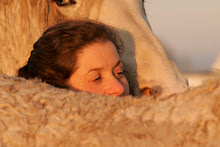.
J'ai reçu aujourd'hui le texte joint ci-dessous... qui confirme ce que je dis depuis des années : le travail en rond de longe (round-pen) est très utile, mais encore faut-il savoir l'utiliser...
Monty Roberts est un excellent homme de cheval. Il les connaît et les côtoie depuis toujours, ses clinics sont stimulantes et fort instructives, mais l'expérience et l'intuition ne peuvent s'acheter dans un livre ou un dvd.
Les débutants sont toujours très impressionnés par les résultats spectaculaires des techniques de join-up et ils se lancent à l'aventure - exaltés par ce qu'ils ont vus en vidéo ou lu dans un bouquin - sans avoir appris à lire et comprendre le cheval afin de décoder rapidement le moindre signe de "fuite" (qui commence entre les deux oreilles par l'idée de fuite) et de ne pas mettre de pression inutile. Le but n'est pas de faire fuir le cheval, mais de lui demander de se déplacer et de prendre le contrôle de son mouvement, même à distance. Chaque cheval est différent, certains bougent au regard, d'autres ont besoin de plus "d'explications". Les seules chevaux qui viennent avec un mode d'emploi applicable à tous sont les chevaux-vapeurs !
:o)Bonne journée !
Isabelle
Remote control horsing.
Cath Henshall has been researching the use of remote control cars when training horses.
SCIENTISTS have challenged the theory behind a popular technique which has been used to train thousands of horses around the world, including those of the Queen.
The Join Up technique, developed by the famed American trainer Monty Roberts, author of The Man Who Listens to Horses, is said to rely on a special non- verbal horse language to alter the animals' behaviour.
But a study led by the equine scientist Cath Henshall, in which people were replaced by remote control cars, suggests the Join Up method works by scaring the animals into submission.
The Join Up technique starts with a trainer chasing an untrained horse around a round pen. As the trainer reduces the intensity of the chasing, the horse approaches and the trainer pats the horse and walks away.
Ms Henshall, who is completing a master's degree in animal science from the University of Sydney, said the approach is considered humane because no physical pressure is applied to the animal and the horse chooses its trainer.
"Two main features of the method are that it depends on the human trainer being able to communicate with the horse using 'horse' body language, and that it is a humane form of training. Our study casts doubt on both those claims," she said.
But Mr Roberts dismissed the findings of the study as an ''absolute joke'', saying the research was an attempt to discredit him.
Ms Henshall and her collaborators used remote control cars to chase 23 horses around a pen.
''The purpose was to see whether we could use a non-human stimulus to get the same kinds of responses that a human can,'' Ms Henshall said.
They found the remote control car could elicit a very similar response in the horse - not running away from the car, and eventually approaching the toy - as Mr Roberts's method.
The results confirmed that the Join Up technique worked because removing something the creature found aversive was rewarding, a behaviour principle known as negative reinforcement, she said.
''The animal doesn't like being chased, it doesn't like being frightened so it learns very quickly how to stop being chased by coming towards the thing that frightens it,'' Ms Henshall said. She will present her findings at the International Society for Equitation Science conference in Edinburgh next week.
Ms Henshall questioned how humane it was to deliberately scare a horse.
Mr Roberts said his Join Up method used both positive and negative reinforcement, and negative reinforcement could be a ''good thing''.
''How do you get a horse to move off your leg? You lay your leg against the horse with pressure and then when the horse steps away you remove the pressure - that's negative reinforcement,'' said Mr Roberts, who advocates non-violence and does not use implements such as whips to control his horses.
He also rejected the study's notion that his methods were inhumane. ''Everybody that ever works with a horse stresses a horse. You will stress a horse when you bring him out of a m eadow,'' said Mr Roberts, who will visit Australia next month.
They have to go through a certain amount of stress in order to accept they are going to live with humans, he said.
Read more: http://www.smh.com.au/environment/animals/science-takes-on-the-man-who-listens-to-horses-20120713-2219x.html#ixzz20bBDhZeL
